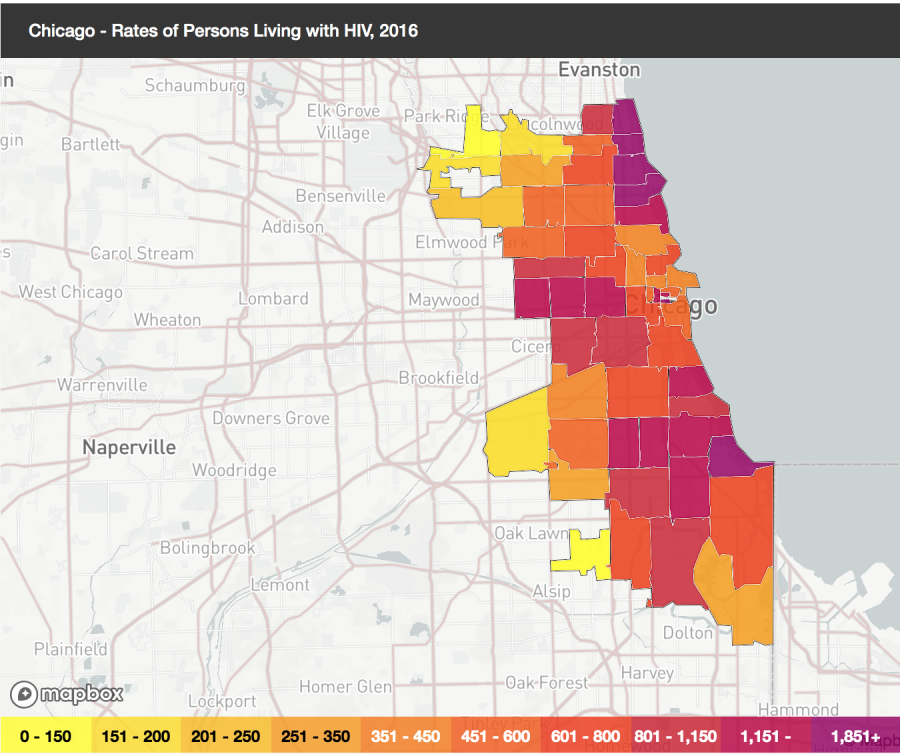HIV/AIDS: the epidemic is far from over
April 27, 2019
The human immunodeficiency virus (HIV) and acquired immunodeficiency virus (AIDS) claims lives by the hundreds of thousands and wrecked entire communities. Though the most devastating number of casualties happened in the 1980s and 1990s and the epidemic is not what it once, the problem is far from over.
Since 1981, there have been 940 thousand people whom have died from AIDS-related diseases globally and 36.9 million people whom are still living with HIV/AIDS. An estimated 5,000 new people are being infected daily as of 2017.
There is an estimate that 45,000 people live with HIV or AIDS in Illinois and of that number, approximately 23,835 live in Chicago. While there are certain neighborhoods with higher numbers of people living with HIV/AIDS, the disease affects the whole city. According to AIDS Vu, there is not a neighborhood in Chicago that didn’t have less than 100 people living with HIV or AIDS residing in it as of 2016.
Black and Latinx men are at a higher risk for contracting HIV than their white counterparts. According to the AIDS Vu organization, their 2016 report stated 53.3 percent of black men, 20.5 percent Hispanic/Latinx men and 23.2 percent of white men were living with HIV in Chicago.
The City of Chicago completed a survey on residents and found that in 2017, there were 752 new HIV diagnoses and 337 new AIDS diagnosis, a slightly lower number than the 824 of new HIV diagnoses reported in 2016. While it appears the numbers of new reported HIV and AIDS diagnoses seem to be decreasing, the number of people living with HIV/AIDS is still high.
However, the reports of women in Chicago living with HIV/AIDS have been growing. In 2016, 18.5 percent of the Chicagoans living with HIV or AIDs were female. The percentage of black females living with HIV were 11.4 times higher and Hispanic/Latinx females living with HIV were 3.3 times higher than white females living with HIV.
There aren’t any cures for HIV/AIDS, but there are effective treatments for HIV, known as antiretroviral therapy (ART), which helps prolong their lives. There is also preventative medication for HIV exposure, Pre-Exposure Prophylaxis (PrEP). This medication can help prevent HIV in those who have not been exposed to the virus.
Even in 2019, there are still people whom have a lot of misconceptions and misunderstandings about contracting HIV/AIDS and people who live with the disease. For starters, HIV and AIDS are not the same thing, even though people, publications and organizations pair them together.
In a nutshell, HIV is the virus that a person contracts, which over time destroys the CD4/T Cells, which are the cells that help the body ward off infections. Whereas, AIDS is the disease that is caused by the permanent damage HIV does to the body’s immune system. AIDS is the most extreme stage of HIV, causing dangerous bacterial and viral infections to wreck more havoc on the body, which leads to eventual death. Not all HIV positive people have AIDS and not all HIV positive people will get AIDS. With the medication and treatment currently available, HIV doesn’t automatically mean it is a death statement.
HIV is carried in semen, vaginal fluids, anal mucus, blood and breast milk. Unprotected sex isn’t the only way HIV is transmitted, there are others such as: an HIV positive mother vaginally giving birth to a baby; sharing needles or syringes to inject drugs, receive tattoos or piercings; getting pricked by an infected needle; or having HIV positive blood, semen or vaginal fluids get into an open wound or sore on your body.
Before the 1980s, blood in blood banks and hospitals were not screened for HIV or AIDS, which caused many people to contract the virus in that way. Currently in the United States, receiving a blood transfusion is safe.
HIV cannot be transmitted via saliva, tears or sweat. This means it is impossible to get HIV by kissing; hugging; sharing drinks or foods; using someone’s eating utensils; holding hands; coughing; sneezing; or using a public toilet seat.
The best ways to prevent the transmission of HIV is to practice safe sex, get tested regularly, not share needles, go to reputable tattoo and piercing shops and talk to your doctor about PrEP.









cassandra benson • Feb 1, 2020 at 5:51 am
HIV can be treated and cured permanently but only few believe it, but I was among those who never believed it until doctor Sikama cured me of HIV , I had HIV for 2 years and it was eating me up one day I found a testimony of someone testifying to the great work of Dr Sikama who cured him of HIV, I was thinking since this man can cure HIV then he must be able to cure HIV and to my greatest surprise he really cured me of HIV, I only message him on WhatsApp via +2348130725051 or email:drsikama@gmail.com and he replied me and we discussed then he sent me the medicine and today am free of HIV All thanks to you Dr Sikama He can also cure the following Hepatitis b Herpes Cancer Tube block Diabetes Fibroid here is his website https://sites.google.com/view/dr-sikama